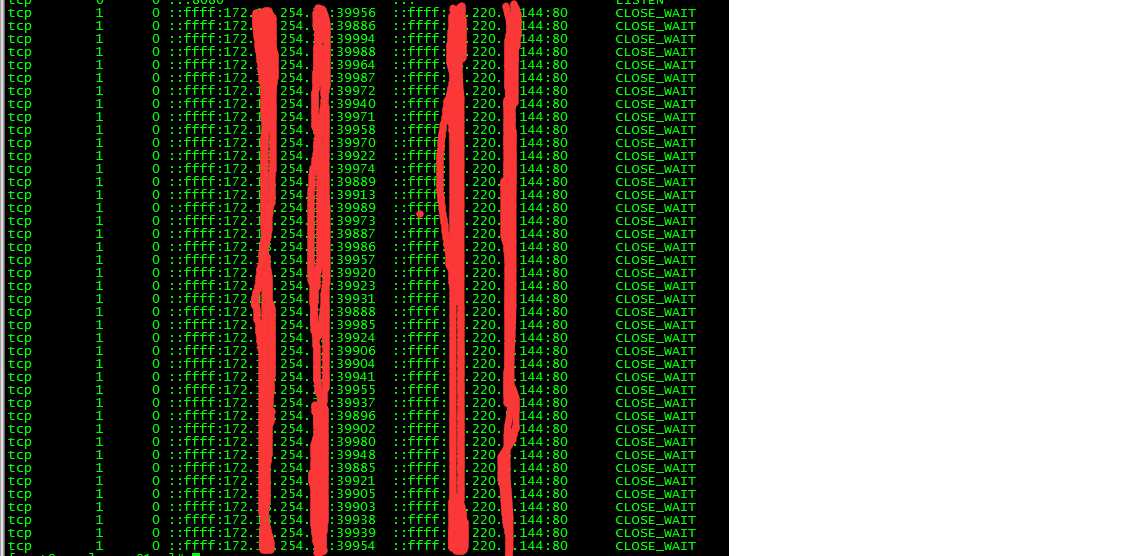标签:
最近发现一个问题,在服务器上通过netstat命令发现有大量的Close_Wait长时间存在,甚至有时候数量接近1000:

查看服务器参数(etc/sysctl.conf):

net.ipv4.tcp_keepalive_time 网管已经修改成1200。
参数值还可以改小,但似乎是治标不治本,出现这种问题,肯定是某个地方的程序本身存在问题。
根据ip及端口信息,不难发现是什么地方除问题了,项目中有涉及到图片上传,于是找到图片上传的代码,结果发现代码非常简单,一行上传权限初始化代码,一行CDN官方提供的一个静态方法,之后就是处理响应结果的代码了。代码少且简单,上传调用代码没什么问题,那么问题可能出在CDN官方提供的jar包了,好在CDN有提供源码,于是查看源码,源码中使用apache 的是httpClient包,调用代码大致如下:
String response = ""; HttpPost httpPost = null; CloseableHttpResponse ht = null; String startTime = formatter.format(new Date());//请求时间 String endTime = "-"; String statusCode = "-"; String contentLength = "-"; String contentType = "-"; try { httpPost = new HttpPost(url); List<NameValuePair> paramsList = new ArrayList<NameValuePair>(); if (file != null) { MultipartEntityBuilder mEntityBuilder = MultipartEntityBuilder.create(); BandwithLimiterFileBody fileBody = new BandwithLimiterFileBody(file, null, "application/octet-stream", null, BaseBlockUtil.maxRate, progressNotifier); mEntityBuilder.addPart("file", fileBody); mEntityBuilder.addTextBody("desc", file.getName()); if (params != null && params.size() > 0) { for (String name : params.keySet()) { mEntityBuilder.addTextBody(name, params.get(name), ContentType.create("text/plain", Charset.forName("UTF-8"))); } } httpPost.setEntity(mEntityBuilder.build()); } else if (params != null && params.size() > 0) { for (String name : params.keySet()) { paramsList.add(new BasicNameValuePair(name, params.get(name))); } HttpEntity he = new UrlEncodedFormEntity(paramsList, "utf-8"); httpPost.setEntity(he); } if (headMap != null && headMap.size() > 0) { for (String name : headMap.keySet()) { httpPost.addHeader(name, headMap.get(name)); } } if(!httpPost.containsHeader("User-Agent")) httpPost.addHeader("User-Agent", Config.VERSION_NO); CloseableHttpClient hc = HttpClients.createDefault(); RequestConfig requestConfig = RequestConfig.custom().setSocketTimeout(30000).setConnectTimeout(30000).build();//设置请求和传输超时时间 httpPost.setConfig(requestConfig); ht = hc.execute(httpPost); endTime = formatter.format(new Date()); Header[] headerArr = ht.getAllHeaders(); for (Header header : headerArr) { BufferedHeader bh = (BufferedHeader) header; if (bh.getBuffer().toString().contains("Content-Length")) { contentLength = bh.getValue(); } else if (bh.getBuffer().toString().contains("Content-Type")) { contentType = bh.getValue(); } } HttpEntity het = ht.getEntity(); InputStream is = het.getContent(); BufferedReader br = new BufferedReader(new InputStreamReader(is, "utf8")); String readLine; while ((readLine = br.readLine()) != null) { response = response + readLine; } is.close(); br.close(); int status = ht.getStatusLine().getStatusCode(); statusCode = String.valueOf(status); if (status == 200) { if (!new JsonValidator().validate(response)) { response = EncodeUtils.urlsafeDecodeString(response); } } return new HttpClientResult(status, response); } catch (Exception e) { statusCode = "500"; endTime = formatter.format(new Date()); throw new HttpClientException(e); } finally { if (httpPost != null) { httpPost.releaseConnection(); } if (ht != null) { try { ht.close(); } catch (IOException ignored) { } } writeHttpLog(startTime, url, "-", (null != params ? params.get("token") : "-"), (null != file ? file.getName() : "-"), "-", "-", endTime, statusCode, contentType, contentLength, response); }
查看TCP协议端口状态说明 , 如果一直保持在CLOSE_WAIT状态,那么只有一种情况,就是在对方关闭连接之后服务器程序自己没有进一步发出ack信号。因此要解决这个问题大致有以下几种方案:
a、实例化httpClient 时,使用alwaysClose 的SimpleHttpConnectionManager
通常默认情况实例化httpClient 的时候使用的是无参构造的SimpleHttpConnectionManager,因此可替换为带参构造:
new HttpClient(new SimpleHttpConnectionManager(true));
b、在method.releaseConnection() 之后 通过获取HttpConnectionManager,进行关闭(getConnectionManager方法在httpclient 4.3之后已经标记为过期,后期可能会移除该方法):
hc.getConnectionManager().shutdown();
c、在method.releaseConnection() 之后 通过获取HttpConnectionManager 调用closeIdleConnections方法进行关闭,(getConnectionManager方法在httpclient 4.3之后已经标记为过期,后期可能会移除该方法):
hc.getConnectionManager().releaseConnection(conn, validDuration, timeUnit);
d、通过设置header由服务端自动关闭.
method.setHeader("Connection", "close");
HTTP协议中有关于这个属性的定义:
HTTP/1.1 defines the "close" connection option for the sender to signal that the connection will be closed after completion of the response. For example:
Connection: close
e、使用MultiThreadedHttpConnectionManager 进行复用,但同时也必须在合适的地方进行关闭处理;
f、请求之后未收到响应信息时,调用method.abort()进行处理
可参考:http://wiki.apache.org/HttpComponents/FrequentlyAskedConnectionManagementQuestions
TCP/IP详解卷一
解决:HttpClient导致应用出现过多Close_Wait的问题
标签:
原文地址:http://www.cnblogs.com/jessezeng/p/5616518.html